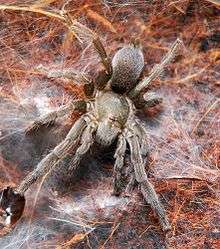Phlogiellus
Phlogiellus is a genus of tarantulas that was first described by Reginald Innes Pocock in 1897.[5]
| Phlogiellus | |
|---|---|
 | |
| Phlogiellus baeri | |
| Scientific classification | |
| Kingdom: | Animalia |
| Phylum: | Arthropoda |
| Subphylum: | Chelicerata |
| Class: | Arachnida |
| Order: | Araneae |
| Infraorder: | Mygalomorphae |
| Family: | Theraphosidae |
| Subfamily: | Selenocosmiinae |
| Genus: | Phlogiellus Pocock, 1897[1] |
| Type species | |
| P. atriceps Pocock, 1897 | |
| Species | |
|
22, see text | |
| Synonyms[1] | |
Species
As of May 2020 it contains twenty-two species and one subspecies, found in Asia, on the Solomon Islands, and in Papua New Guinea:[1]
- Phlogiellus aper (Simon, 1891) – Indonesia (Java)
- Phlogiellus atriceps Pocock, 1897 (type) – Indonesia (Java)
- Phlogiellus baeri (Simon, 1877) – Philippines
- Phlogiellus bicolor Strand, 1911 – Papua New Guinea (New Britain)
- Phlogiellus bogadeki Nunn, West & von Wirth, 2016 – China (Hong Kong)
- Phlogiellus brevipes (Thorell, 1897) – Myanmar
- Phlogiellus bundokalbo (Barrion & Litsinger, 1995) – Philippines
- Phlogiellus inermis (Ausserer, 1871) – Malaysia to Indonesia (Lombok)
- Phlogiellus insulanus (Hirst, 1909) – Indonesia (Sulawesi)
- Phlogiellus insularis (Simon, 1877) – Philippines
- Phlogiellus johnreylazoi Nunn, West & von Wirth, 2016 – Philippines (Palawan Is.)
- Phlogiellus longipalpus Chomphuphuang, Smith, Wongvilas, Sivayyapram, Songsangchote & Warrit, 2017 – Thailand
- Phlogiellus moniqueverdezae Nunn, West & von Wirth, 2016 – Thailand
- Phlogiellus mutus (Giltay, 1935) – Philippines
- Phlogiellus nebulosus (Rainbow, 1899) – Solomon Is.
- Phlogiellus obscurus (Hirst, 1909) – Malaysia (Borneo)
- Phlogiellus ornatus (Thorell, 1897) – Myanmar
- Phlogiellus orophilus (Thorell, 1897) – Myanmar
- Phlogiellus pelidnus Nunn, West & von Wirth, 2016 – Malaysia (Borneo)
- Phlogiellus subinermis (Giltay, 1934) – Southeast Asia
- Phlogiellus watasei (Kishida, 1920) – Taiwan
- Phlogiellus xinping (Zhu & Zhang, 2008) – China
Formerly included:
- P. lucubrans (L. Koch, 1874) (Transferred to Selenocosmia)
- P. subarmatus (Thorell, 1891) (Transferred to Chilobrachys)
gollark: Anyway, I'm never using it myself, as they are uncool and do not support Linux.
gollark: Of course, the potatOS Privacy Policy is far superior to all these ToSes which let you keep your soul.
gollark: I looked into it, and apparently their ToS is vaguely worrying, although to be fair that's... generally the case.
gollark: "oh yes, what a horrible mistake, we accidentally accessed too much data"
gollark: Although it did access steam friends lists without permission.
See also
References
- "Gen. Phlogiellus Pocock, 1897". World Spider Catalog Version 20.0. Natural History Museum Bern. 2020. doi:10.24436/2. Retrieved 2020-06-06.
- Haupt, J.; Schmidt, G. (2004). "Description of the male and illustration of the female receptacula of Yamia watasei Kishida, 1920 (Arachnida, Araneae, Theraphosidae, Selenocosmiinae)". Spixiana. 27: 220.
- Raven, R. J. (1985). "The spider infraorder Mygalomorphae (Araneae): Cladistics and systematics". Bulletin of the American Museum of Natural History. 182: 156.
- West, R. C.; Nunn, S. C.; Hogg, S. (2012). "A new tarantula genus, Psednocnemis, from west Malaysia (Araneae: Theraphosidae), with cladistic analysis and biogeography of Selenocosmiinae Simon 1889". Zootaxa. 3299: 33.
- Pocock, R. I. (1897), "Spinnen (Araneae)", in Kükenthal, W. (ed.), Ergebnisse einer zoologische Forschungsreise in dem Molukken und Borneo
This article is issued from Wikipedia. The text is licensed under Creative Commons - Attribution - Sharealike. Additional terms may apply for the media files.